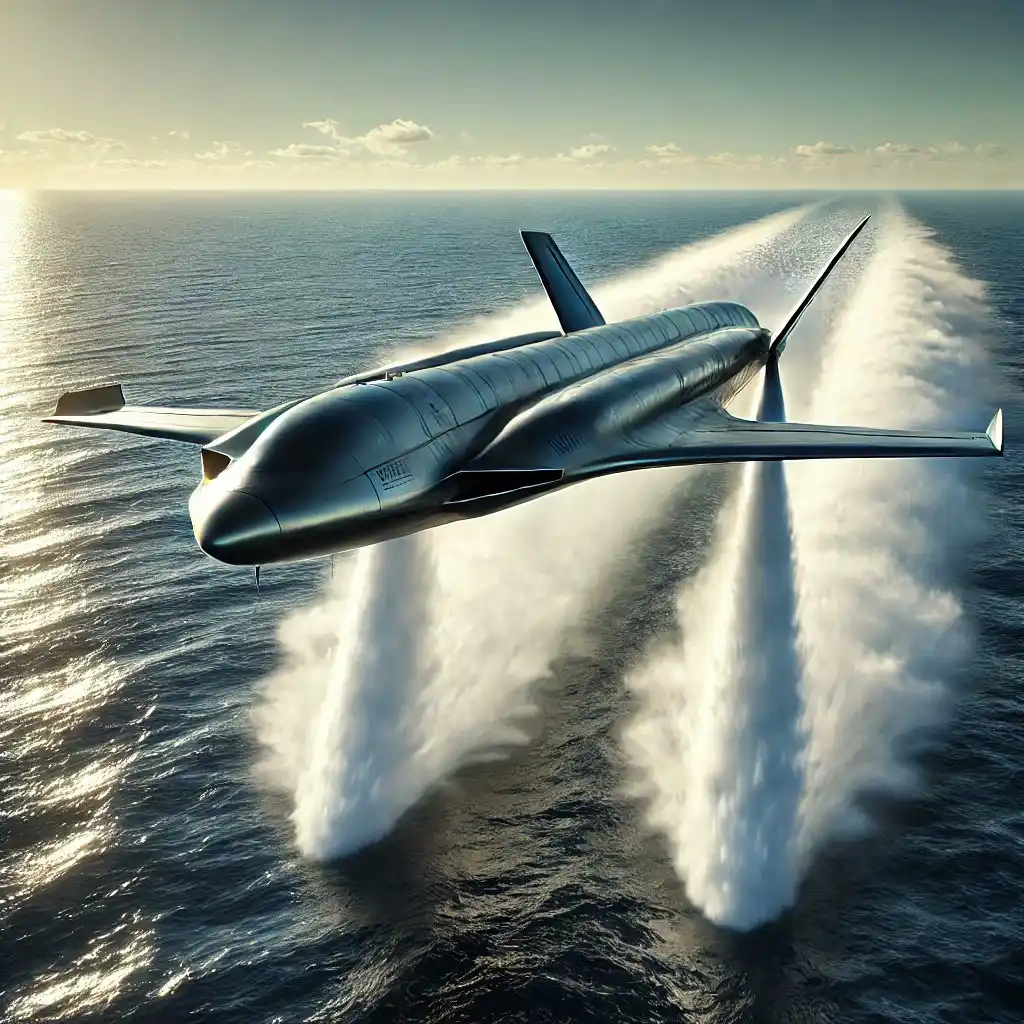Next Generation Hybrid Ground-Effect Missile System Design Report
1. Introduction: Navigating Global Power Dynamics
Opening Context
In the 21st century, the balance of global power between East and West has reached a critical inflection point. China’s meteoric rise in economic, technological, and military domains has fundamentally reshaped the geopolitical landscape, posing unprecedented challenges to Western dominance. Key metrics highlight the scale of this shift:
-
Shipping Capability: China controls 48% of global shipbuiding capacity, dwarfing the United States’ meager 0.2% share. This disparity underscores China’s strategic control over vital maritime trade routes.
-
Shipbuilding Capacity: With shipbuilding infrastructure over 230 times greater than its Western counterparts, China is positioned to dominate naval and commercial fleets for decades to come.
-
Electrical Generation Growth: Over the past 24 years, China’s electrical generation capacity has grown by an astounding 500% to 600%, compared to Canada’s modest 13%. This growth fuels China’s industrial and military advancements, cementing its global influence.
North America’s Challenges
In stark contrast to China’s ascendancy, North America faces a series of systemic challenges that threaten its ability to maintain global influence:
-
Economic Stagnation: Decades of underinvestment in critical industries have eroded the West’s industrial base, leaving it ill-equipped to compete with China’s manufacturing prowess.
-
Underfunded Defense Systems: Budgetary constraints and political inertia have resulted in aging military infrastructure, limiting the capacity to counter emerging threats.
-
Diminished Industrial Output: The offshoring of manufacturing capabilities has weakened North America’s ability to respond to crises, from supply chain disruptions to geopolitical confrontations.
These vulnerabilities underscore an urgent need for innovative solutions to reassert North America’s strategic autonomy and safeguard its sovereignty.
Strategic Vision
To address these challenges, the development and deployment of the Hybrid Ground-Effect Missile (HGEM) system with integrated Multiple Independently Targetable Reentry Vehicle (MIRV) capabilities emerges as a transformative solution. This cutting-edge weapon system combines advanced propulsion, stealth, and modular payload technologies to counter modern naval threats effectively.
The HGEM system is not merely a weapon but a comprehensive strategic tool designed to:
-
Neutralize High-Value Naval Targets: Leveraging precision and overwhelming force to dismantle adversarial maritime dominance.
-
Secure Vital Trade Routes: Ensuring the free flow of commerce by mitigating threats to critical waterways.
-
Reinforce Alliances: Strengthening NATO’s collective defense posture through advanced technological integration.
In an era where maritime dominance shapes global power, the HGEM represents a bold leap forward, bridging the gap between North America’s current vulnerabilities and its aspirational resilience. By investing in this system, the West can reassert its leadership, counterbalance China’s dominance, and secure a stable and prosperous future.
2. Strategic Necessity of the HGEM System
Global Threat Landscape
In the 21st century, maritime dominance has become a decisive factor in global geopolitics. Oceans, which account for 70% of the Earth’s surface, are not just trade conduits but also critical zones for security and power projection. The rapid escalation of China’s maritime capabilities has fundamentally shifted the balance of power:
-
Advanced Logistics and Naval Infrastructure: China’s comprehensive network of ports, shipyards, and logistical hubs enables efficient deployment of naval forces, creating a formidable global presence.
-
Fleet Modernization: The People’s Liberation Army Navy (PLAN) has rapidly advanced its fleet, integrating aircraft carriers, destroyers, and submarines with cutting-edge technology.
-
Strategic Presence: Aggressive development of the “String of Pearls” strategy secures key chokepoints, enhancing control over critical trade routes.
This maritime ascendancy poses significant challenges to global trade, energy supplies, and the geopolitical balance. Countries relying on secure sea lanes for economic stability — including NATO members — find themselves increasingly vulnerable to disruption.
Western Vulnerabilities
In stark contrast, Western nations face considerable hurdles in maintaining maritime security:
-
Limited Industrial Output: While China’s shipbuilding capacity dwarfs its Western counterparts, the latter struggle with declining industrial bases and outdated manufacturing infrastructure.
-
Underfunded Defense Systems: Budgetary constraints have led to gaps in naval modernization, leaving critical vulnerabilities in fleet size and technological sophistication.
-
Strategic Exposure: Key trade routes such as the South China Sea, the Strait of Malacca, and the Arctic face escalating threats, undermining Western economic and security interests.
These vulnerabilities emphasize the urgent need for innovative solutions capable of countering advanced threats, ensuring freedom of navigation, and maintaining sovereign control over territorial waters.
The Role of the HGEM
The Hybrid Ground-Effect Missile (HGEM) system with integrated MIRV (Multiple Independently Targetable Reentry Vehicle) capabilities provides a groundbreaking answer to these challenges. Unlike traditional naval assets, the HGEM is:
-
Strategically Agile: Its ability to operate across underwater, airborne, and ground-effect flight phases ensures unmatched versatility.
-
Technologically Advanced: With precision targeting, hypersonic speeds, and stealth features, the HGEM outpaces current missile technologies.
-
Cost-Effective: Modular design and adaptable deployment options minimize lifecycle costs while maximizing operational impact.
Neutralizing Naval Threats
The HGEM system is specifically designed to neutralize high-value naval targets, including:
-
Carrier Strike Groups: By leveraging swarm-based MIRV capabilities, the HGEM overwhelms even the most advanced layered defenses.
-
Submarine Threats: The underwater mode’s stealth ensures the missile’s survivability during approach phases, evading detection by sonar arrays.
-
Surface Combatants: Precision strikes on destroyers, frigates, and amphibious assault ships disrupt enemy fleet cohesion and operational capabilities.
Securing Strategic Waterways
By safeguarding critical maritime corridors, the HGEM ensures uninterrupted trade and energy flows, bolstering economic stability. Key benefits include:
-
Deterrence: The presence of HGEM-equipped forces acts as a significant deterrent to adversaries contemplating naval aggression.
-
Force Multiplier: The ability to deploy MIRVs against multiple targets simultaneously maximizes the strategic impact of a single launch.
-
NATO Integration: The HGEM’s compatibility with allied naval platforms strengthens joint operational effectiveness.
Supporting Western Alliances
Beyond its tactical advantages, the HGEM system symbolizes a recommitment to Western unity and technological leadership. Its development fosters:
-
Collaborative Innovation: Joint R&D initiatives among NATO allies enhance shared technological capabilities.
-
Economic Investment: Revitalizing industrial sectors and defense manufacturing stimulates economic growth.
-
Strategic Credibility: Demonstrating advanced military capabilities reinforces global confidence in Western alliances.
Conclusion of Strategic Necessity
In an increasingly contested global landscape, the HGEM system emerges as more than a weapon — it is a strategic enabler. By addressing critical vulnerabilities in maritime security and leveraging cutting-edge technology, the HGEM provides a decisive edge in safeguarding Western interests and maintaining the balance of power. This system embodies the innovation and resolve needed to navigate the complexities of modern naval warfare and secure a prosperous future for allied nations.
3. HGEM Design: Engineering Excellence Across Four Phases
The Hybrid Ground-Effect Missile (HGEM) system’s innovative design integrates advanced engineering solutions across four distinct phases of operation. This modular, multi-stage approach ensures versatility, precision, and survivability while addressing the evolving challenges of modern naval warfare. Each phase is optimized for specific operational conditions, leveraging cutting-edge technologies to maximize performance.
Phase 1: Long-Range Underwater Transit (1,000 km)
The underwater phase emphasizes stealth, efficiency, and extended range, allowing the HGEM to traverse hostile waters undetected.
Energy-Efficient Pump-Jet Propulsion
-
Quiet and Efficient: Employs a pump-jet propulsion system for quiet and energy-efficient underwater travel.
-
Operational Stealth: Capable of sustained speeds up to 50 knots, minimizing acoustic signatures and reducing detection risk.
Advanced Navigation and Guidance
-
AI-Enhanced Precision: AI-enhanced inertial navigation ensures precise trajectory control over long distances.
-
NATO Compatibility: Modular navigation systems allow seamless integration with NATO-standard command and control protocols.
Modular Fuel Systems
-
Extended Missions: Optimized for extended missions with energy-dense, multi-fuel configurations.
-
Maximum Underwater Range: Allows a maximum underwater range of up to 1,000 km without compromising payload capacity.
Hydrodynamic Efficiency
-
Streamlined Hull Design: Inspired by bio-mimetic principles observed in marine species, the design minimizes drag.
-
Advanced Riblet Coatings: Further enhance efficiency by reducing turbulence, increasing range and endurance.
Emergency Supercavitation Mode for Underwater Evasion
The Hybrid Ground-Effect Missile (HGEM) system includes an emergency supercavitation mode designed for rapid underwater evasion when detection and pursuit by adversary assets occur. This mode allows the missile to initiate a sudden high-speed escape, creating a vapour bubble around itself to reduce drag significantly, enabling remarkable speeds underwater.
Key Features:
-
Activation Trigger: The emergency supercavitation mode is activated automatically when advanced threat-detection sensors indicate the presence of nearby adversarial underwater assets attempting to pursue or intercept.
-
Supercavitation Bubble Generator: Once triggered, the HGEM employs a bubble generator to create a vapor-filled envelope around the missile, effectively reducing the hydrodynamic drag by minimizing direct contact with water.
-
Extreme Speed and Evasion Capability: In supercavitation mode, the HGEM can reach speeds exceeding 200 knots, allowing it to evade most conventional underwater pursuit systems rapidly. This acceleration, coupled with an unpredictable evasive trajectory, makes interception highly unlikely.
-
Short-Term Stealth Sacrifice: While the supercavitation mode sacrifices some level of acoustic stealth due to the high-speed operation and bubble formation, it provides a critical escape option, prioritizing survival and mission success when under direct threat.
-
Reversion to Standard Propulsion: Upon successfully evading immediate threats, the HGEM system can revert to its quieter, energy-efficient pump-jet propulsion mode to regain its stealth profile and continue towards the mission objective or initiate a strategic repositioning.
Phase 2: Seamless Water-to-Air Transition
Transitioning from underwater to airborne operation requires precise control and robust engineering to maintain stability and stealth.
Retractable Stabilizer Fins
-
Aerodynamic Stability: High-tensile alloy fins deploy during the transition phase to provide aerodynamic stability.
-
Minimal Drag: Retractable design ensures minimal drag during underwater transit and airborne flight.
Micro-Explosive Gas Jets
-
Controlled Ascent: Generate controlled upward thrust to propel the missile into its airborne phase.
-
Low Signature: Engineered for minimal acoustic and thermal signatures to evade detection.
Separation Sequencer
-
Payload Preparation: Coordinates the internal mechanics for MIRV payload preparation during ascent.
-
Seamless Transition: Ensures seamless transition with no disruption to trajectory or mission timing.
Phase 3: Ground-Effect Flight (2,000 km)
Once airborne, the HGEM leverages ground-effect aerodynamics for high-speed, low-altitude travel over extended ranges.
Aerodynamic Wing Design
-
Lift Optimization: Computational fluid dynamics optimize winglets for superior lift-to-drag ratios.
-
Stability: Maintains stability and control within the ground-effect zone (10-20 meters above water).
Ramjet Propulsion
-
Sustained Supersonic Speeds: Enables sustained supersonic speeds, enhancing speed and fuel efficiency.
-
Multi-Fuel Adaptability: Supports extended operational range while ensuring adaptability to various mission requirements.
AI-Driven Altitude Control
-
Precise Altitude: Sensor-driven algorithms maintain precise altitude within the ground-effect zone, avoiding radar detection.
-
Environmental Adaptability: Automated adjustments compensate for environmental factors, ensuring uninterrupted performance.
Phase 4: MIRV Terminal Deployment
The terminal phase introduces an innovative MIRV (Multiple Independently Targetable Reentry Vehicle) system, enhancing strike precision and lethality.
MIRV Deployment Module
-
Multi-Target Engagement: Internal ejection system deploys up to four MIRV projectiles at a pre-determined altitude.
-
Hypersonic Speeds: Each MIRV is capable of independent targeting and hypersonic speeds, ensuring multi-target engagement.
Hypersonic Acceleration
-
Mach 5+ Speeds: Solid rocket boosters within each MIRV propel them to speeds exceeding Mach 5.
-
Thermal Shielding: Advanced thermal shielding ensures structural integrity during high-speed travel.
Coordinated Attack Patterns
-
Swarm Logic: Swarm logic algorithms enable synchronized, multi-angle attacks on high-value naval targets.
-
Optimized Impact Points: AI-driven targeting systems optimize impact points, exploiting vulnerabilities in enemy defenses.
Conclusion
The HGEM’s design philosophy exemplifies engineering excellence by integrating energy efficiency, advanced aerodynamics, and precision targeting. Each phase of operation is tailored to meet the demands of modern naval warfare, ensuring the system’s effectiveness in contested maritime environments. By addressing stealth, survivability, and multi-target capabilities, the HGEM system sets a new standard for missile technology, reinforcing Western defense capabilities against emerging global threats.
4. MIRV Payload Capabilities
The integration of MIRV (Multiple Independently Targetable Reentry Vehicle) capabilities into the HGEM system marks a significant leap forward in offensive versatility, enabling effective multi-target engagement even against highly defended adversaries. This section details the various aspects of the MIRV payload capabilities, ensuring the system achieves superior lethality and strategic flexibility.
Warhead Variants
-
Anti-Ship Penetrators: Designed to pierce heavily armoured naval targets, the anti-ship penetrators are equipped with high-density kinetic energy warheads that can breach the hulls of modern warships. Once penetration is achieved, an internal explosive charge ensures maximum destruction within the vessel, neutralizing critical operational areas.
-
EMP Devices: The MIRV payload also includes electromagnetic pulse (EMP) devices, capable of disabling electronic systems aboard naval vessels without causing physical damage. This feature is especially useful for creating tactical advantages by rendering enemy ships inoperative, effectively blinding and isolating them.
-
Cluster Munitions: Cluster munitions are also part of the MIRV payload to maximize effectiveness against groups of smaller vessels or equipment concentrated in a specific area. Each MIRV can deploy sub-munitions over a wide radius, ensuring broad coverage and making it ideal for destroying auxiliary ships or support craft accompanying larger naval fleets.
Autonomous Design
-
AI-Driven Targeting: Each MIRV is equipped with an autonomous guidance system driven by advanced AI. This system allows for independent targeting capabilities, where each warhead can home in on different targets. The AI is capable of adapting to changing environments, prioritizing targets based on threat level, and executing complex attack patterns to evade enemy defenses.
-
Multi-Angle, Synchronized Strikes: The AI coordination among multiple MIRVs enables synchronized strikes from multiple angles. By attacking from different directions simultaneously, the MIRVs can overwhelm even sophisticated point-defense systems, significantly increasing the likelihood of successful hits on the target.
Stealth Features
-
Radar-Evasive Shapes: Each MIRV projectile is designed with a radar-evasive shape that minimizes its radar cross-section. The aerodynamic design ensures that detection by enemy radar systems is minimized during the terminal phase of flight, increasing the chance of a successful strike.
-
Thermal Management Systems: Hypersonic flight generates extreme heat, which can make the MIRVs susceptible to infrared tracking. To counter this, the MIRVs are equipped with advanced thermal management systems, including heat-absorbing materials and coatings that dissipate thermal energy efficiently, making them harder to detect with infrared sensors.
The inclusion of the MIRV payload in the HGEM system drastically enhances its capabilities, transforming it from a single-target weapon into a multi-target platform capable of delivering saturation attacks. This advancement not only increases the tactical options available to military commanders but also makes the HGEM an effective deterrent against superior naval forces.
5. Advanced Capabilities and Strategic Advantages
Extended Range
The Hybrid Ground-Effect Missile (HGEM) system features an exceptional total operational range of 3,000 kilometers, combining the capabilities of multiple flight phases — underwater transit, ground-effect flight,terminal MIRV deployment and AI driven evasion. The extended range allows the HGEM to penetrate deep into contested waters and carry out strategic operations without requiring frequent launch locations or refueling. This range provides significant standoff capabilities, enabling the safe positioning of allied forces.
Unmatched Speed
The HGEM achieves supersonic speeds during its ground-effect flight phase and even greater velocities during the hypersonic MIRV terminal deployment. The ability to switch from underwater stealth to supersonic travel on the surface, and eventually hypersonic acceleration, renders this system exceptionally difficult to intercept. It ensures the quick execution of strikes, greatly reducing the adversary’s response time and enhancing the likelihood of mission success.
Defensive Evasion
The HGEM system incorporates several advanced techniques to evade defenses effectively. The underwater transit phase makes early detection more challenging, with low-speed, quiet propulsion methods to avoid sonar detection. Additionally, during the terminal phase, the deployment of multiple MIRVs (up to four) in arced and swarm-style attacks overwhelms even the most advanced missile defense systems, saturating the enemy’s interception capabilities and significantly increasing the chances of successful strikes.
Operational Versatility
The HGEM’s design allows deployment from various platforms, including submarines, surface ships, or coastal batteries, enhancing its operational flexibility. This versatility makes the HGEM system a valuable tool in a wide array of strategic and tactical scenarios, from coastal defense to power projection in open waters. Its modular capabilities allow rapid adaptation based on mission requirements, improving allied responsiveness in dynamic threat environments.
Cost-Effectiveness
The modular nature of the HGEM system minimizes development and production costs. Leveraging existing technologies, such as pump-jet propulsion and ramjet engines, helps reduce research and development time while maintaining high performance. Furthermore, the multi-role functionality— acting as both a ground-effect missile and a MIRV delivery vehicle — ensures the system delivers significant value for its cost by replacing the need for separate systems and reducing logistical overhead.
6. Engineering Lessons Learned
Challenges Overcome
-
Transitioning from Supercavitation to Energy-Efficient Propulsion: The initial design of the HGEM system considered utilizing supercavitation to achieve rapid underwater transit. However, the energy demands and noise generation posed a significant challenge for stealth missions. Engineers pivoted to an energy-efficient pump-jet propulsion system, which significantly reduced acoustic signatures and increased operational range. This transition was not without difficulty — optimizing the power output while maintaining speed and endurance required extensive material testing and iteration in hydrodynamic modelling.
-
Addressing Payload Weight while Maintaining Maneuverability: The incorporation of MIRV payloads presented a substantial weight challenge that impacted the HGEM’s agility, particularly during the transition phases. A breakthrough was achieved by employing advanced lightweight composite materials and a modular payload bay design, allowing for precise balancing. The use of AI-driven flight controls also helped optimize weight distribution dynamically, maintaining maneuverability throughout all four operational phases.
-
Refining Seamless Phase Transitions: The HGEM’s four-phase operation required seamless transitions between underwater, surface, ground-effect, and terminal phases. The most significant challenge was synchronizing the activation of stabilizers and propulsion systems to achieve a controlled water-to-air transition. After multiple simulations and prototype tests, engineers devised a solution using retractable stabilizers, combined with micro-explosive gas jets for initial lift, which provided the stability needed for the water-to-air transition without compromising stealth.
Breakthroughs
-
Increased Underwater Range with Stealth: By shifting away from supercavitation to a more efficient pump-jet propulsion system, the HGEM system gained a significant advantage in underwater endurance. The use of advanced sonar-absorbing materials further enhanced stealth capabilities, allowing the missile to travel long distances underwater without detection, thereby extending its operational range to over 1,000 km in the underwater phase.
-
Optimized MIRV Deployment Timing and Sequencing: One of the crucial engineering breakthroughs was in optimizing the timing and sequencing of MIRV deployments during the terminal phase. The HGEM system employs a precise AI-driven ejection mechanism that ensures each MIRV is released at the optimal moment to achieve a swarm-like attack pattern, increasing the likelihood of overwhelming enemy defenses. The hypersonic acceleration capability of each MIRV (Mach 5+) further enhances its lethality and penetration capacity.
-
Integration of Advanced Materials for Durability and Stealth: The development and integration of advanced composite materials played a pivotal role in enhancing the HGEM’s performance. These materials not only reduced the overall weight of the missile but also provided heat resistance during hypersonic flight and minimized radar cross-section for stealth. The use of radar-absorbing and thermally resistant coatings was critical in ensuring the missile’s survivability and effectiveness throughout its entire mission profile.
7. Comparative Analysis
The “Comparative Analysis” section of the HGEM System Design Document will provide an in-depth look at how the Hybrid Ground-Effect Missile (HGEM) system stands out from existing technologies. This section aims to illustrate the technological superiority and unique advantages of the HGEM system over alternative solutions.
Technology Comparisons
Supercavitation vs. Energy-Efficient Propulsion
-
Supercavitation: Supercavitation is a notable technology for underwater missiles, where an air bubble is created around the missile, allowing for extremely high speeds by reducing drag. However, the energy demands and challenges in directional control limit its practicality for long-range missions.
-
Energy-Efficient Propulsion: The HGEM system opts for energy-efficient pump-jet propulsion, which provides greater endurance and a lower acoustic signature, making it stealthier and more reliable for extended underwater operations.
Ground-Effect Flight vs. Traditional Missile Designs
-
Ground-Effect Flight: Utilizing aerodynamic lift generated close to the water’s surface allows the HGEM to achieve a superior lift-to-drag ratio, which in turn minimizes fuel consumption while increasing range and speed. Traditional missile designs that fly at higher altitudes are more easily detectable by radar, while the ground-effect flight profile helps the HGEM remain below enemy detection thresholds, providing a tactical edge in contested environments.
Single-Warhead Systems vs. MIRV Capabilities
-
MIRV Capabilities: The Multiple Independently Targetable Reentry Vehicle (MIRV) capability of the HGEM system represents a significant advancement over single-warhead systems. While conventional missiles deliver a single payload to a target, the HGEM’s MIRV payload allows for up to four warheads to be deployed, each with independent targeting capability. This enables simultaneous engagement of multiple enemy vessels or infrastructure targets, effectively overwhelming adversary defenses.
Performance Metrics
-
Range: The HGEM system boasts a total operational range of 3,000 km, surpassing the range of many conventional missiles. This extended range is achieved through the combination of energy-efficient underwater transit, fuel-efficient ground-effect flight, and advanced propulsion technologies.
-
Speed: The HGEM’s ability to transition from pump-jet propulsion system for quiet and energy-efficient underwater travel or AI evasion in standard underwater mode, to super-cavitation for emergency evasion mode and back to standard pump-jet propulsion underwater mode, and from supersonic ground-effect flight to hypersonic speeds during MIRV deployment (Mach 5+) sets it apart from traditional missile systems. This versatility in speed profiles enhances both the missile’s survivability and lethality, ensuring that it can penetrate advanced enemy defenses.
-
Stealth: Stealth is a core feature of the HGEM system. Unlike traditional missile designs, which often have large radar cross-sections, the HGEM employs radar-evasive shaping and a combination of underwater transit and low-altitude flight to minimize detection. The system also integrates advanced thermal management to reduce infrared signatures, further complicating interception by enemy defenses.
-
Lethality: The lethality of the HGEM system is significantly enhanced by its MIRV payload, enabling swarm-style attacks with hypersonic warheads. The ability to launch multiple warheads that can coordinate their strikes from different angles makes it highly effective against well-defended targets, such as naval battlegroups or hardened coastal infrastructure.
This comparative analysis underscores the strategic advantages of the HGEM system, highlighting its superior range, speed, stealth, and multi-target lethality. By leveraging advanced technologies and a modular design, the HGEM not only meets but exceeds the capabilities of traditional missile systems, providing a critical tool for safeguarding maritime interests and enhancing Western defense capabilities.
8. Implementation Pathway: Building a Collaborative Defense Framework
Research and Development
To effectively develop the Hybrid Ground-Effect Missile (HGEM) system, dedicated investment in cutting-edge technologies is paramount. This includes focused investments in propulsion technologies, materials science, and advanced AI systems. The integration of energy-efficient propulsion requires substantial R&D initiatives to achieve a balance between speed, stealth, and efficiency. Furthermore, collaboration with NATO allies and key international partners can foster shared technological innovation, promoting not only cost-sharing but also diverse expertise in AI-driven targeting systems, advanced aerodynamics, and MIRV payload technologies.
For propulsion systems, partnerships with leading aerospace firms and research institutions can be instrumental. The focus will be on enhancing pump-jet propulsion efficiency for underwater transit and optimizing ramjet propulsion for ground-effect flight, ensuring the HGEM’s seamless transition between operational phases.
Production and Deployment
The production and deployment of the HGEM system require the modernization of existing manufacturing facilities and the development of new, scalable production lines. Modernization efforts will focus on optimizing facilities for producing complex, advanced materials integral to the HGEM’s stealth and durability. Ensuring scalability is key to meeting both initial production demands and any subsequent increase necessitated by evolving geopolitical tensions.
Specialized training programs must be instituted for units responsible for HGEM deployment and operation. This will involve comprehensive training in underwater operations, ground-effect flight dynamics, and MIRV deployment protocols. Additionally, collaboration with NATO for joint training exercises will ensure interoperability among allied forces, preparing specialized teams for multinational deployments and coordination.
Policy and Budgetary Alignment
The successful development and deployment of the HGEM system demand robust policy and budgetary alignment. Given the system’s strategic significance, it is proposed to increase defense spending to 6% of GDP for all NATO member countries, specifically to fund STEM infrastructure required for the advancement of 21st century military energy, transportation, aerospace and space systems, which would include innovative missile defense capabilities. This budgetary expansion is not only vital for covering R&D, production, and training costs but also for ensuring continuous advancements in military technology in response to evolving threats and the build out manufacturing capability and the valuable stockpile required for emergency conflicts.
Addressing current deficiencies in allied forces is crucial to rebuild operational capacity. A comprehensive review of defense infrastructure is necessary to identify and rectify any gaps in personnel, technology, or logistical support, enabling efficient integration of HGEM capabilities into existing defense frameworks.
Strengthening Alliances
Building a collaborative defense framework requires strengthening existing alliances, particularly with NATO. The integration of HGEM capabilities into the broader defense strategies of allied nations will involve conducting joint naval exercises, focusing on the system’s role in securing key maritime routes. These exercises will not only demonstrate the capabilities of the HGEM system but also solidify its role in collective defense.
Strategic integration of the HGEM into NATO’s defense planning will bolster deterrence capabilities, showcasing a unified, technologically advanced front against potential adversaries. Joint R&D projects, shared testing facilities, and collaborative simulations will further enhance alliance cohesion and ensure that all stakeholders are well-versed in the operational intricacies of the HGEM system.
Ultimately, the implementation pathway emphasizes not just the technological development of the HGEM system but also its role in fostering international collaboration and bolstering the collective security of allied nations. By aligning policy, budget, and strategic alliances, the HGEM system can be effectively integrated into Western defense strategies, providing a powerful deterrent against emerging threats.
9. Broader Implications
Military Doctrine
The Hybrid Ground-Effect Missile (HGEM) system represents a significant shift in naval warfare tactics and operational doctrine. By introducing a hybrid approach that combines underwater transit, ground-effect flight, and supersonic speeds, the HGEM reshapes traditional maritime threat responses. Its inclusion in strategic planning will lead to a fundamental evolution in doctrines involving rapid force projection, surprise elements in sea and coastal engagements, and integrated missile defense evasion tactics. The HGEM system compels military planners to rethink defense-in-depth concepts and embrace multi-domain offensive operations, combining the advantages of submarine stealth and aerial speed.
Alliance Strength
The deployment of the HGEM system across NATO and other Western alliances will substantially boost collective deterrence. By equipping allied naval forces with the HGEM, the Western bloc will enhance its operational capabilities and establish a credible counterbalance to China’s rapid military expansion. The system’s integration necessitates joint training exercises, fostering greater interoperability among NATO members and other strategic partners. The shared deployment will also improve real-time coordination of naval and aerial assets, enabling cohesive, multi-nation maritime operations that can respond promptly to emerging threats. The HGEM’s advanced capabilities will serve as a deterrence multiplier, projecting unity and strength.
Economic Stability
Securing key maritime trade routes is pivotal for maintaining global economic stability. The HGEM system offers a strategic tool to safeguard vital sea lines of communication (SLOCs) from hostile threats, ensuring that international trade flows remain uninterrupted. The successful defense of these routes underpins economic sovereignty for Western nations, preventing adversarial power from leveraging shipping chokepoints for geopolitical influence. The assurance provided by HGEM capabilities allows global markets to operate without fear of supply chain disruptions, particularly in industries that rely on rare earth elements, oil, and other critical resources. By maintaining control over maritime commerce, Western nations can uphold their economic interests, counteract coercive tactics, and foster global stability.
10. Conclusion: A Call to Action
Urgency of Development
The global power dynamics are rapidly evolving, with emerging threats and challenges that call for immediate, strategic responses. Inaction in the face of these challenges risks weakening Western alliances and undermining the economic and security framework that upholds global stability. The Hybrid Ground-Effect Missile (HGEM) system is not just an advanced technological asset — it is a crucial component for sustaining maritime dominance, ensuring security, and maintaining the sovereignty of our trade routes and territories. The window to act is closing, and the consequences of delay are dire.
Strategic Legacy
The HGEM system represents more than just cutting-edge engineering; it symbolizes Western resilience, ingenuity, and the capacity to innovate in the face of adversity. By developing and deploying the HGEM, we reaffirm our commitment to defending freedom, preserving economic stability, and fostering a deterrent strong enough to protect our interests. The legacy of the HGEM will be one of bold innovation, strategic foresight, and unwavering dedication to maintaining the balance of global power.
Future Security
Our commitment to the HGEM program will pave the way for a more secure and prosperous future for generations to come. By protecting vital maritime trade routes and bolstering NATO capabilities, the HGEM provides a critical foundation for enduring security, economic growth, and the protection of democratic values. This investment in advanced defense technology is an investment in our collective future, ensuring that our children and future generations inherit a world that is stable, prosperous, and free.
The time to act is now. It is imperative for policymakers, defense leaders, and industry stakeholders to unite behind the strategic vision of the HGEM system. Together, we can build a formidable defense framework that will not only safeguard our present but also secure a promising future — one defined by resilience, prosperity, and freedom.
Title: “The Dark Knight Trilogy Batman Suite” https://www.youtube.com/watch?v=KwrTczo9PXE
Related Content:






